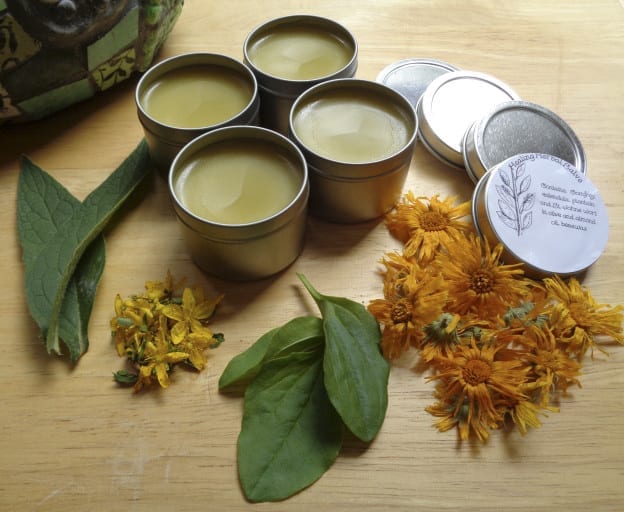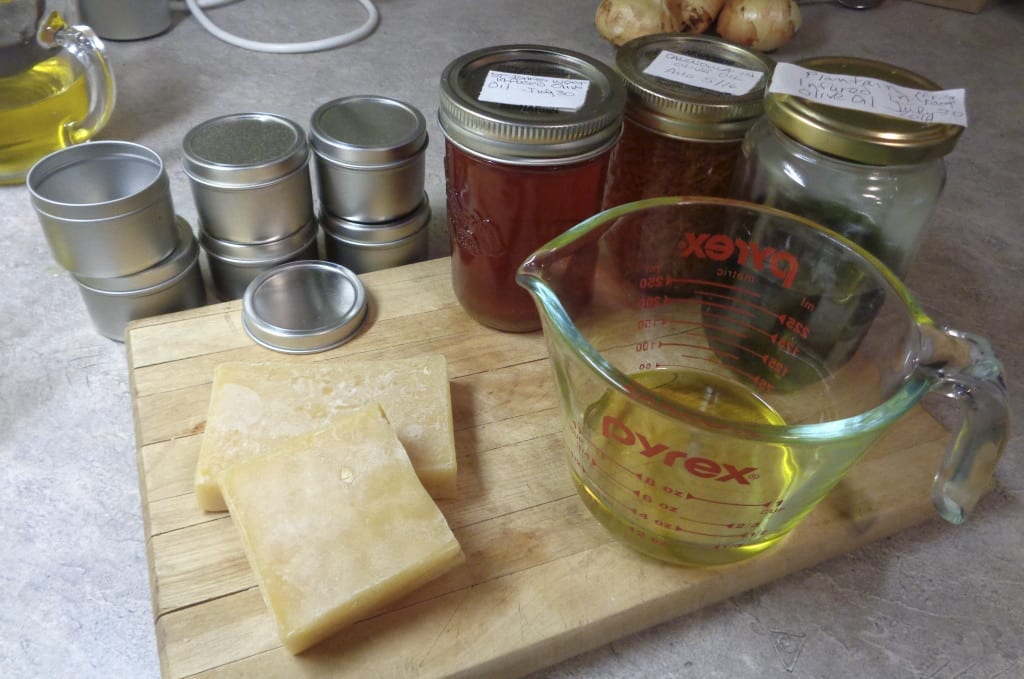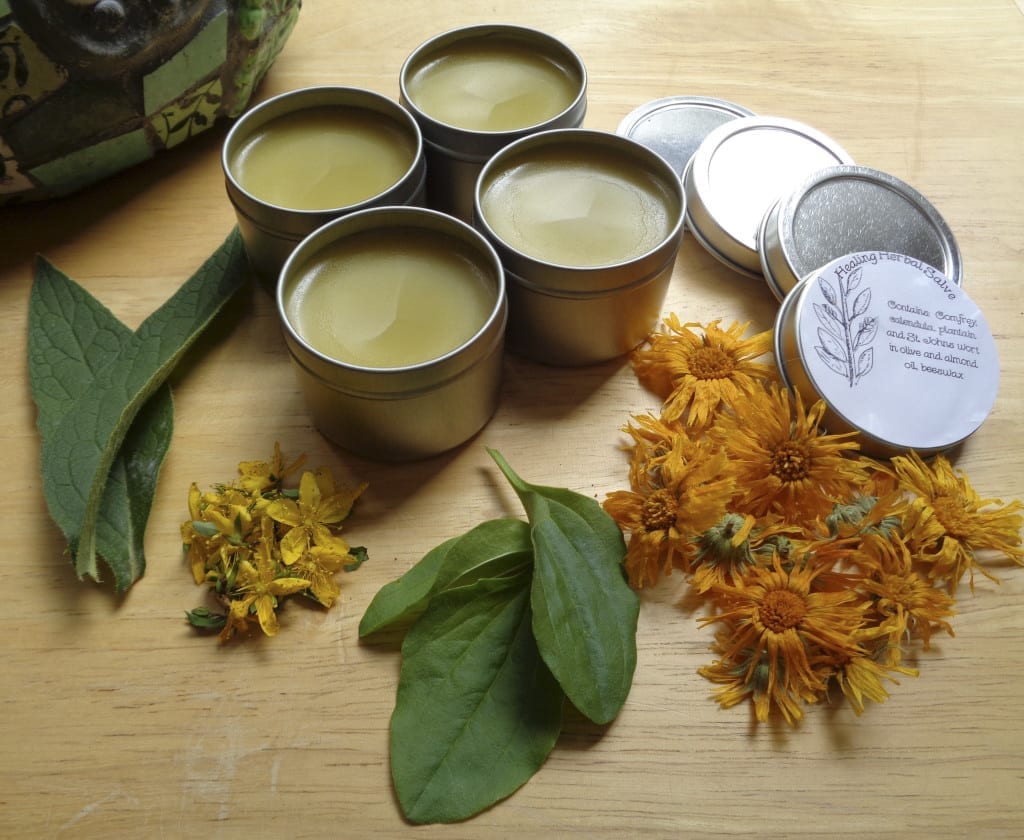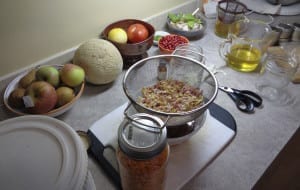 Visiting Jean when she is in creating mode is always such a treat. Her kitchen is full of the smells and bounty of her garden and the treasures she finds along the way. Homegrown garlic in a bowl with a few fresh picked pieces of basil, hawthorn berries gathered from a walk, one last batch of rose petal infused honey dripping into a bowl held up by jars of dried calendula flowers, just harvested heritage apples from the orchard and the means for making todays salve in the background.
Visiting Jean when she is in creating mode is always such a treat. Her kitchen is full of the smells and bounty of her garden and the treasures she finds along the way. Homegrown garlic in a bowl with a few fresh picked pieces of basil, hawthorn berries gathered from a walk, one last batch of rose petal infused honey dripping into a bowl held up by jars of dried calendula flowers, just harvested heritage apples from the orchard and the means for making todays salve in the background.
As the season of harvesting comes to an end, many green thumbs are already thinking about the coming cycle and planning for the goodies they would like to have available next year. Infusing oils for projects takes time and forethought. The plants need to grow, be harvested and then allowed to infuse in oil for at least six weeks to transfer all that goodness into the ingredients for salves and balms.
For that reason, this post is meant more as inspiration for spring and not a suggestion for something to be done in the next few days, when there happen to be ten free minutes ( unless of course, the ingredients are already sitting on your shelf ).
The other option would be to connect with a reputable herb company in your part of the woods and order up the ingredients in question as there is still time to make stocking stuffers for Yule.
You will need:
1 oz. beeswax
1/4 cup each of comfrey, St Johns Wort, plantain and calendula infused oils
4 – 6 containers to hold the finished salve, depending on the size of your choice, preferably light protected.
Let’s start with the infused oils.
Comfrey is an herb used primarily for wounds, sunburn and scratches and a variety of other skin irritations that happen in any busy life.
Plantain, like dandelion, is probably growing in your lawn. Native American cultures used it to heal wounds, break a fever, and to draw out toxins from bites and stings. The plant also has wide-ranging antimicrobial properties as well as being anti-inflammatory and analgesic.
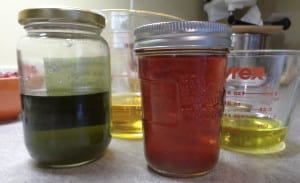 St John’s Wort has been used for a wide variety of conditions, depression and mood swings, anxiety and addictive tendencies, pre-menstrual symptoms and hormonal activity, viral infections and inflammation.
St John’s Wort has been used for a wide variety of conditions, depression and mood swings, anxiety and addictive tendencies, pre-menstrual symptoms and hormonal activity, viral infections and inflammation.
Calendula has a history of being used traditionally for conditions such as conjunctivitis, blepharitis, eczema, gastritis, minor burns including sunburns, warts, and minor injuries including sprains and wounds. Cramps, coughs, and bites. It is thought to act against inflammation and promoting wound healing.
As in all things your wisdom and common sense is needed when working with herbs. It is a large subject, that takes time to learn. The plants described above can contain healing benefits for the conditions mentioned but a salve may not be the best way to receive the benefits for the condition being dealt with. As ever, serious conditions need proper care and attention and education and professional assistance is a first step.
If infusing herbs is new to you, this previous post from Jean’s garden contains more information about calendula and the process involved http://mykitchenwand.com/calendula/
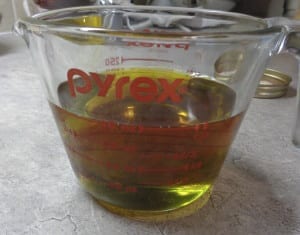 A quick note about viscosity as this picture is a helpful example. When mixing liquids, there is a need to stir effectively as each ingredient has a different weight and some will more likely sink to the bottom while other will more easily rise to the top. The thickness of the liquid is it’s viscosity. Not effectively stirring can have consequences. As one quick example, cinnamon essential oil is very thick and is able to destroy moulds, both candle and soap. So all those lovely fall, All Hallows Eve and Yule scented candles and toiletries can be in danger of not working out if liquids are not well mixed.
A quick note about viscosity as this picture is a helpful example. When mixing liquids, there is a need to stir effectively as each ingredient has a different weight and some will more likely sink to the bottom while other will more easily rise to the top. The thickness of the liquid is it’s viscosity. Not effectively stirring can have consequences. As one quick example, cinnamon essential oil is very thick and is able to destroy moulds, both candle and soap. So all those lovely fall, All Hallows Eve and Yule scented candles and toiletries can be in danger of not working out if liquids are not well mixed.
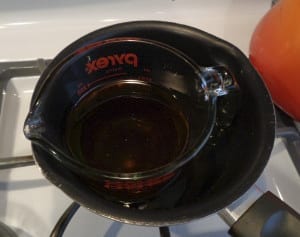 On to salve making! Add 1/4 cup each of the four infused oils, calendula, comfrey, plantain and St John’s Wort into a pyrex measuring cup or something similar and place in a small pot which contains a small amount of water.
On to salve making! Add 1/4 cup each of the four infused oils, calendula, comfrey, plantain and St John’s Wort into a pyrex measuring cup or something similar and place in a small pot which contains a small amount of water.
The reason we are doing this is that beeswax requires 175 degrees F to melt and if the oil is sitting at room temperature ( in autumn in Canada ) the wax will solidify when the oils are added and need to be melted again.
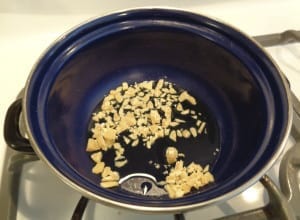 Heating oils too much will affect them and that is not the intention here. We simply need to bring the temperature spread between the oils and the melted wax closer together so the wax does not harden and there is time to pour the salve before the pouring cup contents firm up.
Heating oils too much will affect them and that is not the intention here. We simply need to bring the temperature spread between the oils and the melted wax closer together so the wax does not harden and there is time to pour the salve before the pouring cup contents firm up.
When melting the beeswax, the thinner the beeswax, the more quickly it will melt. Blocks of beeswax should be finely chopped.
Because I don’t make salve on a commercial scale, I cheat, am lazy….am smart! and use natural honeycomb beeswax sheets. They already have a pattern squeezed on them and the pattern helps the beeswax melts quickly. It is easy to tear apart and although it is a little more expensive, well worth the savings in time, especially in a class.
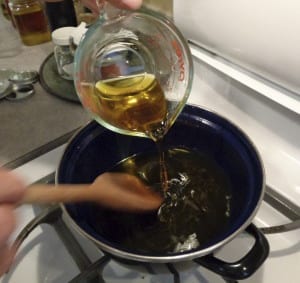 When the wax is melted and the oils warmed, being careful not to add any water from the bottom of the pyrex measuring cup, pour the oils into the wax and stir well.
When the wax is melted and the oils warmed, being careful not to add any water from the bottom of the pyrex measuring cup, pour the oils into the wax and stir well.
Pour the mixture back into the measuring cup and then fill the individual containers.
Pouring the oil into the wax while over a low heat means melting anything that goes hard can happen quickly as it is still over a low heat.
Use oven mitts if your handles are hot and a spatula to get all the goodness inside the pot.
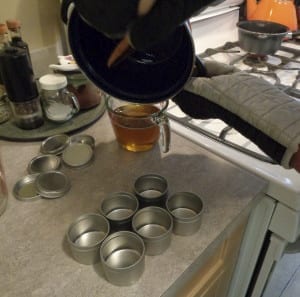 Fill each container to an appropriate level. This recipe made four two ounce containers with a little left over that I got to take home, lucky me!
Fill each container to an appropriate level. This recipe made four two ounce containers with a little left over that I got to take home, lucky me!
Allow the salve to sit quietly as it cools and hardens.
Label the containers with contents then date and store in a cool dark place until needed.
My hope is that seeing how easy making salve is, you will gather plants and make your own in the seasons to come, getting a better understanding of the wealth growing happily around you.
Jean’s Healing Salve from My Kitchen Wand

